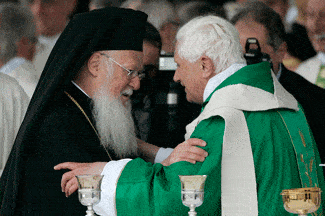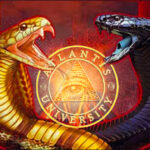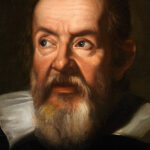Berean Call | Dave Hunt
This article contains excerpts from Chapter 12 of Dave Hunt’s 1990 bestseller, Global Peace and the Rise of Antichrist . Though written more than two decades ago, readers will find much material pertaining to the headlines of today–and tomorrow.
MOST OF THE WARS that have been fought down through history were religious wars. Then, with World Wars One and Two, religion was no longer a factor. The world seemed to have entered a new era where science, not religion, would mediate man’s destiny. If peace were to be established, it would be purely on the basis of political, economic, and military arrangements. Or so it seemed.
In recent years, however, the importance of religion in relation to global peace has become increasingly clear. The strong resurgence of Islamic fundamentalism has confronted the world once again with the specter of “Holy War” fueled by fanatical convictions that cannot be swayed by reason and are impervious to military, economic, or political pressures. It is now apparent that the need for peace among the world’s religions is as great as the need for peace among the world’s nations, and that the latter cannot be achieved without the former. Yet the prospect for bringing peace between warring religious factions seems dim at best. (Indeed, it will happen–but in a way that may surprise everyone.)
Once again, we can glean at least a partial understanding of things to come by turning to history. It was the religious unity achieved under Constantine and his aides, the popes, an office which he created, that ushered in a new era for the Roman Empire. As we have already seen, a similar unity must be realized again if that Empire is to be revived as prophesied.
It was Constantine who called the Council of Nicaea, which is known as the first ecumenical council. Christians look back to it gratefully because it kept out of the church the serious heresy of Arianism, which denied the deity of Christ. Yet Constantine could not have cared less about the theological issues. His concern was getting the bishops to agree–never mind the substance. The following excerpt of a letter from Constantine shows that the whole purpose of his religious policy was to promote political unity:
I had proposed to lead back to a single form the ideas which all people conceive of the Deity; for I feel strongly that if I could induce men to unite on that subject, the conduct of public affairs would be considerably eased. But alas! I hear that there are more disputes among you . . . .
The cause seems to be quite trifling . . . a question in itself entirely devoid of importance; and you, Arius, if you had such thoughts, should have kept silence.
Though Constantine considered the question of Christ’s deity meaningless, he realized that continued disagreement on that issue would have disastrous political consequences for the Empire. Such a dispute could not be allowed to continue. Will Durant explains Constantine’s dilemma and the solution he imposed upon the church:
If division were permitted on this question, chaos of belief might destroy the unity and authority of the Church, and therefore its value as an aide to the state.
The new Emperor who will rule the revived Roman Empire, the Antichrist, is not yet in position to accomplish the essential Constantinian strategy. In his absence, and in preparation for him, an ecumenical union of all religions is being aggressively pursued by [world leaders]. In Geneva, Switzerland, addressing the World Council of Churches (representing 400 million Protestants worldwide), Pope John Paul II declared:
From the beginning of my ministry as bishop of Rome, I have insisted that the engagement of the Catholic Church in the ecumenical movement is irreversible.
Indeed, the “engagement of the Catholic Church in the ecumenical movement” was significant even before the present Pope took office. This fact may seem to be in conflict with its claims of being the only true and infallible church. However, while damning ex-Catholics and Protestants, Catholicism allows for those outside its fold to be saved if ignorant of its claims and sacraments and if they are sincere in their own faith. Thus Mother Teresa and those who work with her never attempt to convert to Christ the dying people for whom they care. Instead, Mother Teresa declares:
If in coming face to face with God we accept Him in our lives, then we . . . become a better Hindu, a better Muslim, a better Catholic, a better whatever we are. What God is in your mind you must accept.
The fact that many people worship false gods, which the Bible condemns, never enters the equation. Mother Teresa proclaims the counterfeit “gospel” that Protestants endorse by joining Catholics in “evangelizing the world.” Examples of such [spiritual] harlotry among Catholic leaders are legion.
A month before his death, celebrated Catholic monk Thomas Merton told an ecumenical gathering of representatives from numerous religions in Calcutta: “My dear brothers, we are already one. But we imagine that we are not. And what we have to discover is our original unity.” Merton was echoing not only Mother Teresa but what many other Catholics, including popes, have long been saying. For example, three Catholic priests state in their book, which bears the official Imprimatur:
We should not hesitate to take the fruit of the age-old Wisdom of the East and “capture” it for Christ. . . .
Many Christians who take their prayer life seriously have been greatly helped by Yoga, Zen, TM, and similar practices.
John Paul II has publicly encouraged such a synergistic attitude. At the Universities of Calcutta and New Delhi in his 1986 visit to India, for example, the Pope told huge Hindu audiences:
India’s mission . . . is crucial, because of her intuition of the spiritual nature of man. Indeed, India’s greatest contribution to the world can be to offer it a spiritual vision of man. And the world does well to attend willingly to this ancient wisdom and in it to find enrichment for human living.
What an incredible statement from the head of “the one true Church” regarding an idolatrous, demon-worshiping religion that has brought absolute horror to India! Try to imagine the apostle Paul in Athens and, instead of arguing against its idolatry, as he did, praising the “ancient wisdom” of Zeus worship and suggesting that Greek paganism had a valuable “spiritual vision of man” to offer to the world! Yet such is Roman Catholicism today, as it has been since the days of Constantine. And such it must be to play its last-days role in helping to establish a new world order based upon the [“new”] religious tolerance.
Merton wrote that “Buddhism and Christianity are alike in making use of ordinary everyday human existence as material for a radical transformation of consciousness.” He taught that the transformation of consciousness, which Zen Buddhism calls “the Great Death,” was identical to what Christians call “dying and rising with Christ”–that both led to the “death of self” and to a “new life” not found in some future paradise but in “living here and now.” Not so! The irreconcilable difference between Christianity and every other religion is Christ Himself and His death, burial, and resurrection on this planet for our sins. Christ’s purpose was to reconcile us to God so that we could live not just “here and now” but forever with Him in heaven. Ecumenism denies the essential uniqueness of Jesus Christ. The Apostle Paul didn’t try to die to self through mystical techniques, which are popular today among Catholics/Buddhists/Hindus/New Agers and increasingly even among professing evangelical Christians. His death to self came about by faith in Christ’s death for his sins–a faith that is not only absent from but specifically rejected and opposed by the basic tenets of Hinduism, Buddhism, and other religions.
The Roman Catholic hierarchy has a long history of leadership in ecumenism. A book could be filled with examples, but a few must suffice. Popes John XXIII and Paul VI joined such notables as the Dalai Lama, Anwar el-Sadat (a Muslim), and U.N. Secretary General U. Thant (a Buddhist), to form The Temple of Understanding, known as the United Nations of World Religions. Its Director of International Programs is Luis M. Dolan, C.P., a Catholic priest. Catholic Archbishop Angelo Fernandes was for its first eight years the President of the Geneva-based World Conference on Religion and Peace, organized to bring together “a growing network involving all the major religions of the world.” When Fernandes retired, he was replaced by ten presidents representing six world religions.
“His Holiness” the Dalai Lama, who is “God” to most Tibetan Buddhists, has been well received by Roman Catholic leaders around the world. He met twice with Pope Paul VI and has met five or more times with his good friend John Paul II.
“Both of us have the same aim,” says the Dalai Lama. At the start of his first U.S. tour, the “God-king-in-exile” was feted in 1979 at New York’s St. Patrick’s Cathedral at what Time magazine called “an extraordinary interreligious festival” hosted by Cardinal Cooke. Declaring that “all the world’s major religions are basically the same,” the Dalai Lama was given a standing ovation by the overflow crowd. Said Cardinal Cooke:
This is one of the dramatic movements of the Spirit in our time. We make each other welcome in our churches, [Buddhist] temples and synagogues.
By “Spirit,” the Cardinal meant the Holy Spirit, but ecumenism in fact involves an alien spirit. Jesus called the Holy Spirit not only the Comforter but “the Spirit of Truth, whom the world [i.e. non-Christians] cannot receive” (John:14:17). That “all the world’s major religions are basically the same” is a lie aimed at the exclusive claims of Christ. The ecumenical movement is a denial of biblical truth and particularly of Christ’s claim that He is the only Savior and that all must believe on Him or be lost forever.
Another Catholic leader who was a major promoter of global religious unity was Augustin Cardinal Bea, a Jesuit and for 19 years Rector of Rome’s Pontifical Biblical College. Cardinal Bea annually hosted “Agapes of Brotherhood,” which were attended by hundreds of international guests representing the world’s major religions: Buddhists, Muslims, Shintoists, and everything in between. Typical of the Cardinal’s speeches was one at the Seventh Agape, in which he “stressed the brotherhood of man and the Fatherhood of God, which, he said, embraces all men.” Yet Jesus told even the religious Jews, “Ye are of your father the devil” (John:8:44) and warned Nicodemus that he must be “born again” by the Holy Spirit to become a child of God or he couldn’t see God’s kingdom.
Cardinal Bea, who was Pope Pius XII’s personal confessor and a close advisor to several other popes, saw the blossoming Charismatic movement as a vehicle for Roman Catholicism’s ecumenical goals. The Cardinal sought out David DuPlessis (known as “Mr. Pentecost”), whom he invited to the Second Vatican Council. DuPlessis and other leading Pentecostals and Charismatics accepted gladly and became Rome’s unwitting pawns. Thus began a growing acceptance of Catholicism by Protestant Charismatics. Today’s Charismatic movement is a major bridge to Rome.
Another promoter of religious unity who used the Charismatic movement to further Rome’s ecumenical aims was Leon Joseph Cardinal Suenens. The Cardinal was influential in the General Council formed in the early 1970s by Shepherding/Charismatic leaders–a Council which secretly guided the Charismatic movement for years. The minutes for its May-June 1977 meeting reveal that Cardinal Suenens was an unknown directing hand behind the scenes:
We, as a Council, are committing ourselves to work together with the Cardinal for the restoration and unity of Christian people and world evangelization in projects to be mutually agreed upon.
In each project, headship, authority and method of functions will be mutually determined by the Cardinal and the Council in the light of the requirements of each situation.
“World evangelization” with Suenens, who promoted a false gospel? For example, the Cardinal had hosted and given the opening speech at the Second World Conference on Religion and Peace in Louvain, Belgium, in 1974. The Louvain conference, which received Pope Paul VI’s blessing, particularly emphasized the important role that religious unity must play in establishing the coming world government. A continual call was sounded for “a new world order.” Under Catholic leadership, the Louvain Declaration stated:
Buddhists, Christians, Confucianists, Hindus, Jains, Jews, Muslims, Shintoists, Sikhs, Zoroastrians and still others, we have sought here to listen to the spirit within our varied and venerable religious traditions . . . we have grappled with the towering issues that our societies must resolve in order to bring about peace, justice, and ennobling quality of life for every person and every people. . . .
We rejoice that . . . the long era of prideful, and even prejudiced isolation of the religions of humanity is, we hope, now gone forever. We appeal to the religious communities of the world to inculcate the attitude of planetary citizenship. . . .
While the Catholic hierarchy and especially the Pope fulfill the major directing role, ecumenism has a broad leadership, including even Korean Messiah Sun Myung Moon. This burgeoning movement has been laying the foundation for a “new world order” for years. Its main appeal for unity is the desperate need for global peace. Moon, founder of the Inter-Religious Federation for World Peace, declares: “All men and women of religion should now tear down the walls of sectarianism . . . for the greater goal of
. . . world peace.” Walls have indeed come down. Calling him “the most brilliant anticommunist and the number one enemy of the state,” Moscow News added happily that it was “time to reconcile” after Gorbachev had “personally hosted Moon in the bowels of the Kremlin.” Moon responded that the Soviet Union, which he formerly equated with Satan, was going to “play a major role in the plan of God to construct a world of peace.” How swiftly the pieces begin to fit into place.
Another facet of the ecumenical movement involves “Interfaith Councils,” which are springing up around the world. Encouraging such ecumenism, the Pope has declared that “Christians must work with [all] other religions to secure peace.” He has pledged that “the Catholic Church intends to ‘share in and promote’ such ecumenical and inter-religious cooperation.” To that end, the Catholic Church maintains an ongoing dialogue with representatives of the four major non-Christian religions. Writing in The Tibetan Review(and quoted enthusiastically in Catholic World ), a Buddhist monk evaluated the goals of this dialogue:
The unity of religion promoted by the Holy Father Pope John Paul II and approved by His Holiness the Dalai Lama is not a goal to be achieved immediately, but a day may come when the love and compassion which both Buddha and Christ preached so eloquently will unite the world in a common effort to save humanity from senseless destruction, by leading it toward the light in which we all believe.
To Pope John Paul II must go much of the credit for the fact that the huge and globally interconnected ecumenical movement is now exploding. Just as Gorbachev has changed the political world, so the Pope has changed the religious world.
Using his immense prestige and the emotional appeal of global peace, the Pope was able in 1986 to gather the leading figures of 12 world religions together in Assisi, Italy, to pray to whatever “God” each believed in, beseeching these deities to bring peace to the world. To justify honoring the prayers of even witch doctors and fire worshipers, John Paul II told participants that “the challenge of peace . . . transcends religious differences.”
The Pope’s unprecedented ecumenical accomplishments have inspired many world leaders and have resulted in new [and nearly innumerable] ecumenical movements for world peace. One of the most significant of these, the Global Forum of Spiritual and Parliamentary Leaders on Human Survival, began almost unnoticed in October 1985, when “spiritual leaders” from the world’s five major religions and elected officials from five continents met to explore ideas for ecological salvation and world peace. Out of this meeting grew a working partnership between the world’s religious and political leaders–an alliance that had been unthinkable since the days of ancient Rome:
We have explored the nature of the relationship between political and religious life, and . . . have agreed that we both need and desire to work together . . . and shall promote at regional, national and local levels all possible collaboration between spiritual leaders and parliamentarians.
We are entering an era of global citizenship. This new consciousness transcends all barriers of race and religion, ideology and nationality. . . . We hold up the vision of a new community, where the long and tragic history of human violence gives way to an age of mutually assured welfare and peace.
Such an ecumenical partnership between religious and political leaders is essential to the rise of Antichrist.
“Christian psychology” has [also] played a vital and unrecognized role in setting the stage for such unity. It represents the ultimate ecumenism in which Christians join not merely with other religions but with atheists and humanists as well. Christ becomes the partner of Freud, Jung, Rogers, Maslow, and a host of other anti-Christians whose theories supply that part of “God’s truth” which was apparently left out of the Bible through Holy Spirit oversight. Psychology provides the common language for a “spiritual dialogue” between Christians and humanists that leads to a new ecumenical mutual “understanding.”
Psychology’s false idea that we must always be “positive” and never criticize anyone subtly encourages the delusion that all religions are equally valid. Such false “Christianity” no longer holds truth to be important and thus can be embraced by the followers of all religions without changing their own beliefs. It lays the perfect foundation for the rise of Antichrist.
A well-known organization, which promotes that same gospel, must be mentioned because of its importance. Freemasonry secretly fosters ecumenism and quietly prepares its members to accept and be part of the coming new world order. What makes Masonry so influential is the fact that so many of its millions of members occupy leadership positions around the world. In our own country, there is nearly always a significant percentage of Masons on the White House staff and in the Cabinet, Senate, Congress, Supreme Court, and Pentagon, as well as in top business management.
Masonic authority Carl H. Claudy boasts of Masonry’s tolerance of all religions: “Masonry does not specify any God of any creed; she requires merely that you believe in some Deity, give him what name you will . . . any god will do.” Albert Pike, former Supreme Pontiff of Universal Freemasonry, likewise exults:
Masonry [is that religion] around whose altars the Christian, the Hebrew, the Moslem, the Brahman [Hindu], the followers of Confucius and Zoroaster, can assemble as brethren and unite in prayer. . . .
So the Pope’s ecumenical prayer gathering at Assisi was only repeating publicly what Masonry has been practicing privately for centuries. That fact is extremely significant if we have indeed (as the evidence seems to indicate) arrived at that time in history when the Roman Empire is about to be revived, setting the stage for a new world order, with its accompanying new world religion acceptable to all faiths. Clearly Masonry has prepared many of those who are presently world leaders to play a key role in these events because they have already been practicing in secret what the world one day must embrace openly. Consider the following prayer given in the opening ceremonies for the 31st degree of the Scottish rite:
Hear us with indulgence, O infinite Deity. . . .Let the great flood of Masonic light flow in a perpetual current over the whole world and make Masonry the creed of all mankind.
In spite of the fact that it is an undeniably anti-Christian religious cult, Masonry has among its members many who call themselves Christians. Their influence as church leaders contributes to the fact that in mainstream denominations the uniqueness of Christ is increasingly being denied. Early in 1990, at its annual convention, the Michigan Episcopal Diocese refused to vote upon the resolution that “Jesus is the Christ, ‘the only name given under heaven by which we may be saved.'” The resolution, which simply quoted the Bible, was called “divisive and demeaning to people whose faith in God is as strong as ours though it is differently defined.” A substitute resolution was voted upon and passed, which committed Episcopalians to proclaim a “Good News” that could be affirmed by every religion and thus had no saving value.
Behold the emergence of the ecumenical apostate church, the bride of Antichrist! “Positive Christianity” is the enemy of the Cross. The truth offends those who don’t want to hear it.
Yet to speak anything less is to trifle with the eternal destiny of souls. Ecumenism’s promise of “unity” is tempting, but it denies Christ and paves the way for the Antichrist and his new world religion. It is a unification that will ultimately lead to destruction.
There is now no stopping the exploding ecumenical movement with its embrace of all religions. America’s most highly respected Christian psychologist [Dr. James Dobson] refers enthusiastically to the “great camaraderie among the top leaders of virtually all religious groups in the United States.” A group of Christian theologians has called for “a move away from the insistence on the superiority or finality of Christ and Christianity toward a recognition of the independent validity of other ways.” They justify such heresy by saying that “economic, political, and especially nuclear liberation is too big a job for any one nation, or culture, or religion.”
Is it mere coincidence that both religious and political unity are coming together at this moment? The time is ripe. Even Iraq’s naked aggression in taking over Kuwait in August 1990 became the basis for giving the world new hope for an end to military conflict. As Marlin Fitzwater, White House spokesman, declared: “The process of war is forging a new blueprint for world peace.”
The unprecedented solidarity of the members of the United Nations (including many Arab states) standing together against [Saddam] Hussein’s aggression has given rise to the optimistic hope that at last the U.N. is fulfilling its purpose. Keeping the peace worldwide suddenly seems to be a viable possibility, causing political leaders to join the religious world’s call for a “new world order.” After being discussed privately between President George H.W. Bush and his aides, the theme of a “new world order” began to come out openly for the first time. Just before leaving for Helsinki, Finland, early in September 1990 to discuss the Persian Gulf crisis at his summit meeting with Soviet President Gorbachev, Bush expressed the hope that “the foundation for the new world order would be laid in Helsinki” and that it would be established under the United Nations. At the news conference with Gorbachev following their historic meeting, President Bush declared optimistically:
If the nations of the world, acting together, continue as they have been we will set in place the cornerstone of an international order more peaceful than any that we have known.
Pushing that same theme following the summit, Secretary of State James Baker declared on the nationally televised program Face The Nation on September 10, 1990, “We’re on the verge of forming a new world order.” In the past, such talk would have been dismissed as Utopian nonsense, but now the media was taking it seriously. Time magazine reported that “the Bush administration would like to make the U.N. a cornerstone of its plan to construct a new world order.” Newsweek magazine said, “As George Bush fished, golfed and pondered the post-cold-war world in Maine last month, his aides say that he began to imagine a new order.” Newspapers across the country carried headlines such as “President to hail ‘new world order.'” and quoted a senior White House official who (referring to the Bush/Gorbachev meeting) declared: “I think it’s . . . a very hopeful sign that we’re entering a new world order where the East-West, US-Soviet competition is not going to be the dominant event.”
Addressing the United Nations on September 25, 1990, Soviet Foreign Minister Eduard Shevardnadze denounced Saddam Hussein’s actions as a “threat to a new world order.” Interestingly, Mikhail Gorbachev was the first world leader to come out publicly with talk of a “new world order,” and he did so nearly two years before George Bush caught the vision. In his historic address to the United Nations on December 7, 1988, the Soviet President made this dogmatic and even prophetic statement:
Further global progress is now possible only through a quest for universal consensus in the movement towards a new world order.
The credibility of this idea no longer seems in question. That new world order, however, will be ruled by the Antichrist. The religious preparation for his rise to power is as essential as the political. Both are well underway. To consummate the process, one vital ingredient is missing, which God Himself will supply.













